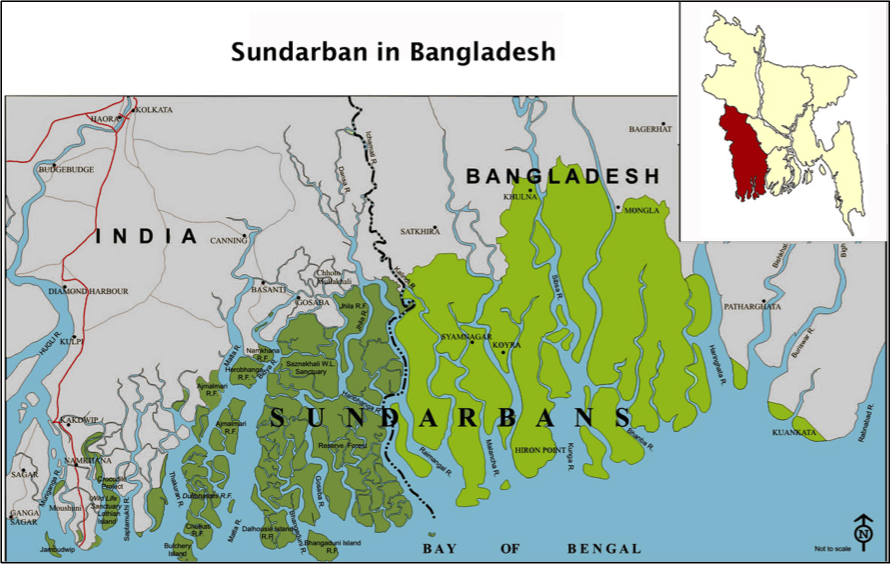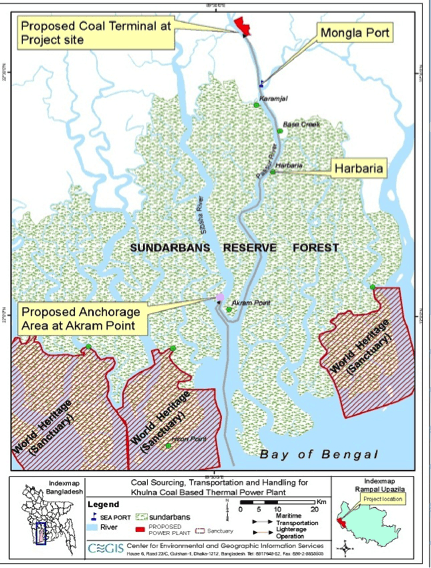**Did you know that the Sundarbans Reserve Forest is the world’s single largest mangrove forest?
**Did you know that mangrove forests are exceptionally important to a biodiversity of species, including the Royal Bengal Tiger?
**Did you know that mangrove forests also serve as a buffer against climatic events and natural disasters such as cyclones, floods, and storm surges for thousands of families?
**Did you know that the Sundarbans Mangrove Forest is the proposed site for a coal-fired power plant project that will release pollutants like carbon monoxide, nitrogen oxide, sulfur dioxide, and hydrocarbons?
If you answered no to any of these questions, do not fret! Keep reading to learn more!

Figure 1. Approximately 60% of the Sundarbans Mangrove Forest is located in Bangladesh and the other 40% in India.
The Sundarbans is located at the mouth of the world’s largest delta, the Ganges Delta. The sediments of the three great rivers of Bangladesh: the Ganges, Brahmaputra, and Meghna, form the Bangladeshi side of the Sundarbans. The Sundarbans Reserve Forest is broken up into three different sanctuaries: Sundarbans East, West and South, along the islands and chars of the Khulna, Satkhira, and Bagherat Districts. The name Sundarbans derives from the word “Sundari,” which means beautiful. It also happens to be the name of the largest and most available mangrove trees of that area. In 1997, the Sundarbans was declared a UNESCO World Heritage Site, and is home to over 49 species of mammals, 315 species of birds, 53 species of reptiles and 8 species of amphibians, many of which are endangered and on the verge of extinction.
The Sundarbans is also home to over 300 species of trees, including mangroves, which are a predominately salt-tolerant ecosystem, with the exception of the Sundari mangrove that is less salt-tolerant. In Bangladesh, the Sundarbans Reserve Forest provides valuable protection for various nearby coastal communities against climate change impacts by creating a buffer against flooding, tidal surges, tropical storms and cyclones. Climate change-induced sea level rise will cause for these delicate mangrove systems to loss their ability to be a shield against stronger, more intense storms. As such, the loss or weakening of the mangrove forest will escalate the disaster risk for these communities against cyclones and storm surges.
So what is happening in Bangladesh? Why should we be concerned about an ecosystem located thousands of miles away?
In 2010, the Indian National Thermal Power Corporation (NTPC) and Bangladesh’s Power Development Board (PDB) proposed building the 1,320-MW Rampal Power Station. The coal-fired power plant would be constructed within 14 km of the Sundarbans! Fueling the power plant running will require 4.72 million tons of coal each year. As shown in Figure 2, this will create an unprecedented increase in water transportation of various voyages of 80,000-ton freight ships cutting right through the delicate mangrove forest ecosystem! An 80,000-ton freight ship is the equivalent of a fully stocked 18-wheeler trailer truck.
Many Bangladeshi environmentalists are concerned about these coal-carrying ships, as they are often the source of high quantities of fly ash, coals dust and sulfur being released into the air, which can negatively affect the nearby mangroves. There is also a higher likelihood of these ships releasing different types of wastes into the water like coal residue, ballast water, oil, lubricant, etc., which can pollute the water the mangroves are trying to filter. Furthermore, the ships traveling along the Passur River will generate more wave activity that can amplify the riverbank erosion already plaguing the area. Communities in the area are already affected by climate change impacts like flooding, riverbank erosion, sea level rise, storm surges, and so this coupled with the potential impacts of the coal-fired power plant will create a difficult environment for the mangroves to remain capable of being a strong buffer for the people living along the chars and coast.
Considering the environmental impacts, how has the Bangladeshi government approved of the project?
The Bangladeshi government has rejected various Bangladeshi environmental organizations and climate change experts’ allegations that the Rampal Power Station Project will adversely impact the Sundarbans. Their argument is based on the release of an Environmental Impact Assessment (EIA) conducted by the Bangladeshi government, which states that the environmental impacts of the project will be minimal due to the use of “high quality coal” and that the proposed distance from the Sundarbans is not a problem.
Because coal-fueled power plants are known to cause serious environmental harm, it is unusual for a country to give permission to set up a large coal based power plant within 20 to 25 km of a forested, agricultural land, protected, or residential area. As is shown in Figure 3, the distance of the proposed Rampal Power Plant is only 14 km from the Sundarbans, a protect wildlife reserve, which the EIA stated to be a “safe” distance. However, because Bangladesh does not have an explicit law or guideline that gives a minimum distance for coal-based power plants to be constructed from reserves, the project is not subject to any legal infractions.
“There are many alternatives for power generation, but there is NO alternative for Sundarban!” What are the Bangladeshi people doing?
Bangladeshi activists have protested and demanded for the Bangladeshi government to listen to the claims of the Bangladeshi people. Many of the communities most affected by the project are working together on a campaign for the Bangladeshi government to see why the Sundarbans must not be disturbed. With climatic events getting worse every year, they are in desperate need of preserving their strongest natural protection.
Many Bangladeshi environmental organizations have pointed out that the project is in clear violation of the Bangladesh Environment Conservation Act of 1995, which protects reserves, like the Sundarbans, from harmful projects. They have also argued that the Bangladeshi forcefully and illegally acquired 1,834 acres from nearby communities for the project before the Environmental Impact Assessment was even completed.
Protestors are demanding for the Bangladeshi government to explore alternative sites for the power plant or to look for alternative energy projects that will not harm the Sundarbans.
What can you do?
Well, there are many options:
- One way to be part of stopping the construction of the Rampal Power Station and helping protect countless ecosystems is to sign this petition that will be sent to the NTPC in India.
- You can also send letters to or call:
Indian National Thermal Power Corporation (NTPC)
NTPC Bhawan
SCOPE Complex, Institutional Area,
Lodhi Road
New Delhi – 110003
+91 11 24360100 - Bangladesh’s Power Development Board (PDB)
Chairman Office
WAPDA Bhaban (1st Floor)
Motijheel, Dhaka -1000
+95 66 061 -5, Ext. 401
- Check these links out to find out more about what is happening!
In 2013, Bangladeshi protestors released a call for international support on their campaign against the Rampal Power Plant, to learn more read this.
As part of their call for international support, Bangladeshi protestors have also released this second call for international financial institutions to NOT fund the Rampal Power Plant Project.
The Future of Coal: An E360 Report released this article that addresses the harmful ecological effects the Rampal Power Plant will cause for the Sundarbans Mangroves.
If you have any more questions regarding how the Environmental Impact Assessment conducted failed to address the environmental concerns posed by Bangladeshi environmentalists, read this article.
Remember, talk about this very important issue with a sibling, parent, friend, school, classmate, or community! Be part of the change! Stay informed!

